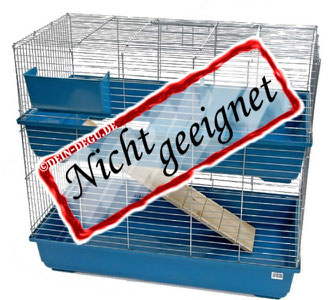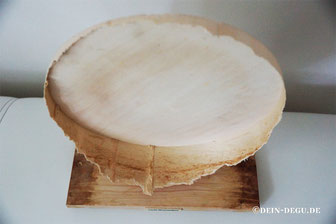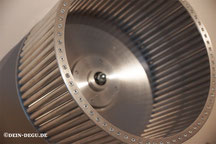Housing, Cages and Stuff
ONLINE TRANSLATED *WILL BE UPDATED SOON
Topics of this subpage:
-
Example cage - suitable cages to buy (links)
- Size of the cage and location
- Cage facility and litter
- Not suitable as a cage
- The cog
- Dividing grille
- Outlet
THE CAGE
How many degus can be kept with a certain cage size ultimately depends on how well the cage is set up, the age of the degus, whether and how often they are allowed to run free. Ultimately, the following applies when choosing the cage: the bigger, the better.
Degus live in the wild mainly on the ground and in earthworks. They only occasionally climb into the lower branches of bushes. When it comes to degustation, this means that they primarily need walking areas. In general: the running surface should be the length of the cage. In addition to a large base area, which best suits your needs, the use of the height through full floors is very important, especially when space is limited, i.e. continuous areas with a minimum of 100x50cm, better over the entire length of the cage, with a distance of 30-50cm .
A continuous area of at least 0.5m² must be available for each animal. The size of 100 x 50 x 100 cm (L x W x H) for a maximum of 2 must not be under any circumstances.
A self-built cage with an all-round stable 1x1cm grid (bird grid / not to be confused with rabbit wire that degus can easily gnaw through) offers sufficient air exchange, but the litter and leftover food also fall out. The same is true of a bird aviary, which has a grid all around. The dirt falls out and the degus will rob you of your last nerve by always gnawing at the bars.
Tip: If you already have a cage made of lattice your own, it is advisable to attach an approx. 10cm high Plexiglas pane to the lower end of the cage, which prevents the dirt from falling out.
Glass terrariums or self-made cages with plexiglass plates are therefore best for degus. An air slot must of course be planned, ideally on the lid and in the lower third of the cage.
If the cage is equipped with wooden shelves, it is advisable to apply a layer of clear toy paint / baby paint on the floors. Toy paint / baby paint is an absolutely harmless, solvent-free and robust paint. The degus do not damage their health if they eat the boards or floors. My cage boards are all made of pressed wood panels (OSB) from the hardware store, the boards are robust and my previous Degu generations did not like the gnawing of the boards.
My first cage can be seen in the following pictures, information about my current cage can be found under Breeding information - Our cage.
Conclusion: If you prefer to buy a finished cage, I recommend a glass terrarium or OSB terrarium. There are already terrariums with levels (e.g. from Terra Ott). Terrariums / aquariums with a grid attachment are also suitable.
SUITABLE CAGES *available in Germany
The size of 100 x 50 x 100 cm (L x W x H) should not be undercut. The facility must be designed by yourself.
SIZE OF THE CAGE AND LOCATION
Degus walk several kilometers a day in nature, so they need a very spacious cage with a large footprint.
- A continuous area of at least 0.5m² must be available for each animal .
- Minimum dimensions: 120 x 60 x 80 cm (L x W x H) ( base: 0.6m² walking area: 1.2m²) with floor + 1 full floor for a maximum of 2 degus . The veterinary association for animal welfare specifies the absolute minimum size of 100 x 50 x 100 cm (L x W x H) + 2 full rods for 2 degus (status 2011).
- Low standard : 120 x 50 x 100 cm (L x W x H) (floor area: 0.6m² walking area: 1.8m²) with floor + 2 full floors for 2-3 degus. Or 120 x 60 x 100 cm (L x W x H) (floor space: 0.72m² walking area: 2.16m²) with floor + 2 full floors for 3-4 degus.
- Medium standard: from 120 x 60 x 120 cm (L x W x H) with floor + 2 full floors for max. 4 degus (floor area: 0.72m², walking area: 2.16m²)
- Higher standard: 150 x 60 x 160 cm (L x W x H) with floor + 4 full floors for 5-6 degus (floor space: 0.9m² walking area: 4.5m²) or 120 x 60 x 160 cm (L x W x H) with floor + 4 full floors for 4-5 degus (floor area: 0.72m², walking area: 3.6m²)
The deguheim must be in a draft-free room that should be light and at a good temperature. The cage must not stand directly on a radiator or in the blazing sun - risk of overheating! Degus feel most comfortable at eye level or just below.
The following information is not a fixed guideline, but a guide. In general: the running surface should be as long as possible in the length of the cage. 100cm is the minimum length, 120cm, 140cm, 150cm, 200cm or more are better than 220cm in height! For the width / depth of the cage, it is recommended to take from 60cm, 80 often prove to be ideal, but most cages are adapted to the living space, this means 50 / 60cm, so these two sizes are chosen as an example in the table.
| Number of degus |
Minimum size cage |
Number of full levels |
Recommended dimension (from) |
Number of full levels |
| 2 | 100 x 50 x 100 cm | 2 + floors | 120 x 60 x 100 cm | 2 + floors |
| 3 | 100 x 50 x 130 cm | 3 + floors | 120 x 60 x 140 cm | 3 + floors |
| 4 | 100 x 50 x 160 cm | 4 + floors | 120 x 60 x 160 cm | 4 + floors |
| 5 | 100 x 50 x 200 cm | 5 + floors | 120 x 60 x 200 cm | 5 + floors |
| 6 | 120 x 50 x 200 cm | 5 + floors |
120 x 60 x 200 cm 150 x 60 x 160 cm |
5 + floors 4 + floors |
| 7 | 120 x 50 x 230 cm | 6 + floors | 150 x 60 x 200 cm | 5 + floors |
| 8 | 150 x 50 x 200 cm | 5 + floors |
170 x 60 x 200 cm 200 x 60 x 160 cm |
5 + floors 4 ++ floors |
ESTABLISHMENT AND LITTER
The cage must be equipped with several full floors in order to ensure the best possible use of the space. Full floors are planes that span the full length and width of the cage. Branches, roots, stones, clay pipes, cork pieces / tubes, houses and other hiding places make the cage varied and ensure constant wear of the claws and teeth.
LITTER
As litter, my degus receive beech wood litter and tree bark with different types of litter - herb land - forest & meadows - heathland - forest floor - leaves & needles (1-2 packs per cage approx. 2-5 cm high). This litter contains both gnawing material and additional food. Hemp litter is also suitable, the manufacturer can be freely selected.
FLOORING
As additional protection for the wooden levels or in the case of glass levels, it is advisable to place a mat on top.
Are suitable:
-
Black cork plates, thickness 2 cm
-
Hemp mats / farrowing mats
- Coconut fiber back wall
DIGGING BOX
Degus dig underground passages in the great outdoors, so if the cage does not have a sufficiently high floor pan, you can integrate a digging box into the cage using a small aquarium.
The aquarium can be filled with a mixture of sand and peat, which is slightly moistened so that the corridors in it remain stable. Bark mulch can also be added to the digging box. A recommendation is the use of terrarium humus, humus substrate, or coconut bricks used in terrariums, these are sterilized and sold in a dried, compactly pressed form. After adding water, there is a larger amount of soil.
There is no one hundred percent recommendation for the content of the bottle box at Degus, but it must be ensured that the content is fertilizer-free, perfume-free and sterilized.
SAND BATH
Degus are very clean animals, so a container with chinchilla sand must always be available to them in which they can wallow and care for their fur. Degus are only allowed to be "bathed" in water in health-related cases, their fur draws moisture and therefore degus would catch cold quickly.
Any chinchilla sand is suitable.
- Quartz sand
- Attapulgus without attapulgite * see below
- without sepiolite
Not suitable:
- Bird sand ** see below
- Sandpit play sand, building sand
- Aquarium sand
Tip: 25 kg chinchilla sand, natural white, very fine, soft chinchilla bath sand / on ebay for 8.49 EUR.
* Attapulgite is suspected of being cancerous, but if the bathing sand is only used in small quantities, as is the case with keeping small animals, a harmful effect cannot be confirmed, according to the Hanover University of Veterinary Medicine. The suspicion of cancer discussed in the media can be traced back to much larger quantities in which the sand is directly processed and thus inhaled. In principle, all fine dust, inhaled in large quantities, can cause cancer, including normal house dust. This problem can be discussed with the construction workers in Attapulgus, but not with the keeping of small animals. "
** Bird sand mainly consists of quartz-containing sand to which crushed fragments of mussel shells (so-called grit), ground grit and aniseed oil are sometimes added.
STONES
My degus run on quartzite polygonal slabs or slate slabs and also have raw rose quartz stones in the cage.
All natural stones are suitable:
- Quartzite, granite, slate, marble
However, these stones should not be used:
- Limestone, soft sandstone
- Artificial rocks or artificial stones like Ytong
- Aquarium stones (all types)
Many stones such as rainbow stones with the typical round holes are not real natural stones but polyresin replicas. The basis for the production of artificial stones is a special plastic that is usually reinforced with fiberglass (GRP rocks).
HIDING AND CLIMBING OPPORTUNITIES
The following furnishing accessories are suitable:
- dry branches, e.g. pine branches, fruit trees, birch, willow, hazelnut
- Cork, grapevines, mangrove roots, bamboo
- All tube types Ø min. 10 cm (diameter)
- Wooden house without painting / sealing or with toy paint
- Wooden suspension bridges or tunnels
- Clay / ceramic tubes or pots
- Hammocks
-
- Sisal rope / coconut rope, not as access to the next level, only as a toy
- Coconuts or the shell as a food bowl for seeds, for example
Not suitable:
-
Plastic of any kind
- Remove needles, pine cones and resin residues from the branches
TOYs
- Bricks with holes - stick branches or nibbles into them
- Wooden tubes with holes on the sides - stuff nibble sticks or treats with hay into them
- Fasten the wooden ball hanging from a rope
- Willow ball with hay and treats
- Crumpled cardboard tube with treats or food inside
- Rubbing box with various leaves, hay, fodder, twigs
- Karlie Rody Brain Train Roll
- Willow tunnel, can also be mounted hanging (to gnaw)
NOT SUITABLE AS A CAGE
Commercially available small animal cages are not suitable for degus, as degus gnaw their way through plastic, thin wood or sheet metal very quickly. Cages with plastic tubs are particularly unsuitable, as they gnaw on plastic particles can be swallowed, which can cause serious illness.


Wheel
Degus have a great urge to move, so they always have to have a cog available. Plastic is immediately gnawed by degus and if swallowed can lead to the death of a degus. Metal wheels were declared unsuitable for the species and are therefore no longer available. However, the cog does not replace a spacious cage!
Running plates are an alternative, but I do not consider them to be healthy or particularly beneficial due to their inclination and the way degus have to walk on them.
The currently best choice of a wheel is a wooden wheel with a minimum diameter of 30cm, but unfortunately some degus like to eat it.
Tip: the cog can be bought around 30-50% cheaper on the Internet than in retail.
However, since my degus are very naughty and have already dismantled some wheels, I ordered two full aluminum wheels with 0mm distance between the bars. I decided on a stand, so the wheel can be screwed on and won't slip anymore.
The full aluminum wheels are the best purchase I could make, I am completely convinced of the quality. Even when the degus is running fast in the wheel, nothing can be heard, the wheel runs completely silently thanks to the ball bearing. For all those who are concerned about whether a distance of 0mm is too narrow, my degus have no problem with it, there have been no jammed paws or anything else. Even the youngsters use the cog!
DIVIDING GRILLE
Should it ever be necessary to separate a degu from the group due to disputes or to socialize a new degu to the existing group , there must be a possibility of separation by means of a
partition.
The separated compartment should offer enough space for at least one degu and should be placed in the cage in such a way that it is in the middle on one
level so that there is enough contact area with the other degus.
The dividing grille should be a double grille so that you only have one grille to reduce the risk of bites.
Running area
Of course, tame degus are allowed to run out, by tame it means that the degu can be caught again without any problems. I would limit the degu's access to the room in which the cage is located. Before the degu can exercise, sources of danger such as watering cans, ashtrays, filled glasses, candles or other pets must be moved out of the degu's reach.
Degus also like to gnaw on cable / sockets, so it is recommended that you either turn them off or block the path for the degus. Particular attention should be paid to the possibilities to lock the degus are squeezed behind cupboards or shelves (e.g. through books), here they are difficult to get out again.
An outdoor enclosure like the one offered in stores for rabbits / guinea pigs is not suitable for degus. The bars are too far apart for the degus to squeeze through. The following applies to degus - if the head fits through, they are gone! If you still want to give the degus a chance, I recommend subsequently reinforcing the outdoor enclosure with a stronger 1x1cm grille. To do this, attach the grid to the enclosure with wire. The degus should not go unnoticed, however, as they are good climbers and also good at digging.
All texts and contents are subject to copyright, © dein-degu.de





























